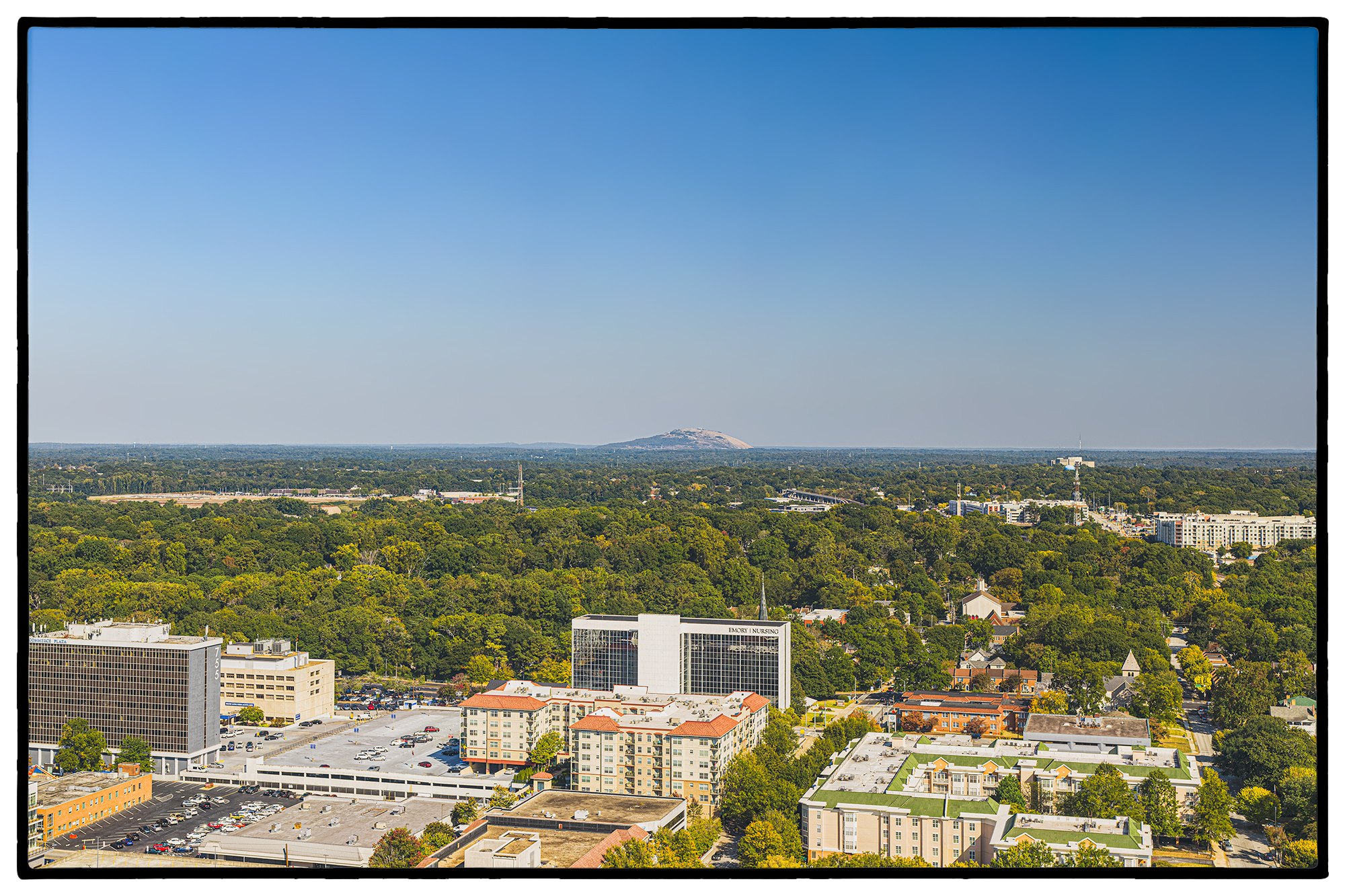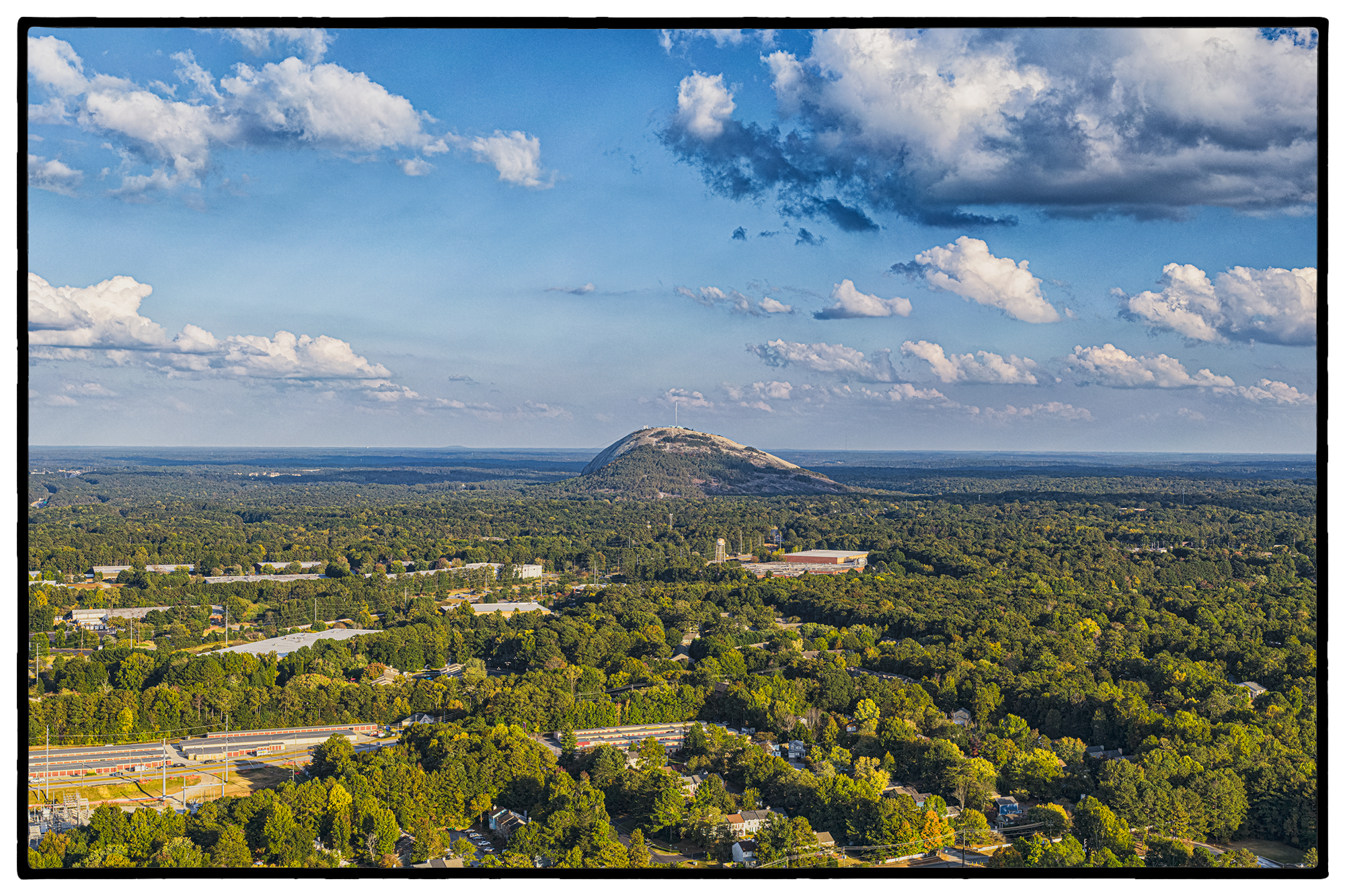thirty-six views of stone mountain (2023)
Scarred by a carving of Civil War generals Robert E. Lee, Stonewall Jackson, and Jefferson Davis, Stone Mountain is the world’s largest bas-relief sculpture and looms over the City of Atlanta, visible from 20 miles away. When Dr. Martin Luther King spoke at the March on Washington, he demanded “Let freedom ring from Stone Mountain on Georgia.” Only when that occurred, Dr. King insisted, could we possibly become “Free at Last, Free at Last, thank God Almighty… free at last”.
Inspired by the Japanese artist Hokusai’s Thirty-six Views of Mount Fuji from 1832, I decided to make Thirty-six Views of Stone Mountain. I started at the Stonehenge Mansion, near my own home in Atlanta, where Klansman Samuel Venable sketched out the monument a century ago, flying my drone camera over the treeline to see the mountain looming in the distance. Dividing the 15 miles ahead by Hokusai’s 36 views, I stopped every half a mile to launch my drone and photographed the mountain looming ever closer until it filled the frame. Animated into video, the resulting scene echoes Stanley Kubrick’s iconic low helicopter flight that opens The Shining (1980), approaching the mountain landscape from an evolution of angles that simultaneously orients and disorients.
As my camera approaches the Georgia monolith, you hear the soundtrack swelling before it becomes evident that the Confederate carving has been digitally erased.
Hokusai, The Inume Pass in Kai Province (1832)
the photographs (click to enlarge)
View One: 33° 46' 29.25" N 84° 20' 28.674" W
View Two: 33° 46' 17.58" N 84° 19' 30.108" W
View Three: 33° 46' 18.774" N 84° 18' 45.72" W
View Four: 33° 46' 29.586" N 84° 17' 54.918" W
View Five: 33° 46' 40.536" N 84° 17' 6.732" W
View Six: 33° 46' 43.854" N 84° 16' 38.496" W
View Seven: 33° 47' 4.104" N 84° 16' 15.504" W
View Eight: 33° 47' 12.786" N 84° 15' 55.53" W
View Nine: 33° 47' 33.696" N 84° 15' 51.18" W
View Ten: 33° 47' 53.112" N 84° 15' 34.782" W
View Eleven: 33° 48' 11.094" N 84° 15' 10.734" W
View Twelve: 33° 48' 15.906" N 84° 14' 41.334" W
View Thirteen: 33° 48' 33.03" N 84° 14' 26.04" W
View Fourteen: 33° 48' 56.244" N 84° 14' 9.162" W
View Fifteen: 33° 49' 9.24" N 84° 13' 46.974" W
View Sixteen: 33° 49' 4.824" N 84° 13' 35.07" W
View Seventeen: 33° 49' 6.042" N 84° 13' 5.724" W
View Eighteen: 33° 49' 10.638" N 84° 12' 39.696" W
View Nineteen: 33° 49' 27.174" N 84° 12' 14.238" W
View Twenty: 33° 49' 34.602" N 84° 11' 48.936" W
View Twenty-one: 33° 49' 56.412" N 84° 11' 47.28" W
View Twenty-two: 33° 50' 14.316" N 33° 50' 14.316" N
View Twenty-three: 33° 50' 38.298" N 84° 11' 59.352" W
View Twenty-four: 33° 51' 0.612" N 84° 11' 15.132" W
View Twenty-five: 33° 50' 52.434" N 84° 10' 40.692" W
View Twenty-six: 33° 50' 43.794" N 84° 10' 17.01" W
View Twenty-seven: 33° 50' 21.942" N 84° 9' 51.96" W
View Twenty-eight: 33° 50' 1.428" N 84° 9' 32.418" W
View Twenty-nine: 33° 49' 42.054" N 84° 9' 17.556" W
View Thirty: 33° 49' 49.404" N 84° 8' 38.688" W
View Thirty-one: 33° 49' 48.294" N 84° 8' 16.158" W
View Thirty-two: 33° 49' 34.332" N 84° 8' 10.608" W
View Thirty-four: 33° 49' 22.452" N 84° 8' 14.73" W
View Thirty-six: 33° 48' 54.408" N 84° 8' 35.016" W


































